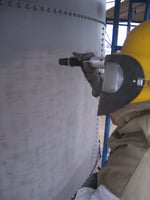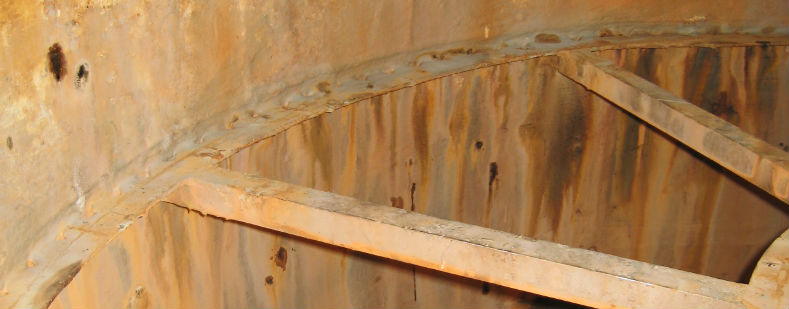Every manufacturing facility and production plant around the world have tanks on their property. These tanks contain a number of different things - some tanks contain liquids like water used for cooling, while others store waste from the manufacturing process. Some tanks hold finished product in the form of liquids or gas. All tanks are built to meet specifications created to prevent tank ruptures. Unfortunately, a tank can perfectly conform to design specifications and still be affected by corrosion and coatings failure. Over time corrosion can lead to structural or tank wall failure creating both an environmental and safety impact.
Most modern tanks are built from metal, but some are made of fiberglass.  Typically these tanks are coated using a material that will help resist corrosion. If a tank is for drinking water, this coating may be specified simply to prevent rust from developing inside the tank. Alternatively, if a tank is built to contain acid, a more resistant coating may be needed.
Typically these tanks are coated using a material that will help resist corrosion. If a tank is for drinking water, this coating may be specified simply to prevent rust from developing inside the tank. Alternatively, if a tank is built to contain acid, a more resistant coating may be needed.
Tanks may also need to have coatings removed for “change of service.” Some substances can induce corrosion faster than others, so a more heavy duty tank lining may be needed. In most cases when a tank liner must be replaced, a tank must be cleaned to a “White Metal Blast” finish. This (as well as the specified anchor profile) provides an ideal surface for recoating.
Inspections are very important to maintain the integrity of the tank and to determine when a tank must be cleaned and recoated. After years of use (or in some cases sooner when coatings haven’t been applied properly) a tank’s coating will start to fail. Usually a tank will have one type of coating on the interior and a different type of coating on the exterior. Coating failure (and tank corrosion) can happen on either the inside or the outside of the tank.
 Cleaning and preparing the inside of a tank for a new coating can be difficult. These confined spaces are often a challenge to maintain enough continuous air movement (face velocity) to adequately clear airborne dust created during surface preparation. Visibility is a challenge for workers blasting tanks with material like coal slag - a sandblasting abrasive that generates high dust. Workers must be extremely careful when blast cleaning tanks with ordinary abrasives due to injuries caused by rebound and ricochet. Sponge Media™ abrasives are well suited for tank cleaning due to its ability to remove coatings and profile metal while entrapping dust at the source and drastically lowering abrasive rebound.
Cleaning and preparing the inside of a tank for a new coating can be difficult. These confined spaces are often a challenge to maintain enough continuous air movement (face velocity) to adequately clear airborne dust created during surface preparation. Visibility is a challenge for workers blasting tanks with material like coal slag - a sandblasting abrasive that generates high dust. Workers must be extremely careful when blast cleaning tanks with ordinary abrasives due to injuries caused by rebound and ricochet. Sponge Media™ abrasives are well suited for tank cleaning due to its ability to remove coatings and profile metal while entrapping dust at the source and drastically lowering abrasive rebound.
Tank cars are used in the railway industry to transport many different kinds of commodity all over the world. Like regular tanks, tank cars are coated based on the type of material they will be carrying. Sponge-Jet has developed the Robotica, a special rail car robot that can grit blast cars to remove linings or clean the steel substrate of unlined cars to a white metal blast quickly and efficiently, while maintaining a consistent, high-quality substrate, free of blast imperfections found in hand blasting. The result is a substrate designed to maximize coating life. Robotic tank car cleaning can even be done on difficult to remove linings like Plasite® 9570 and Enviroline® 2900. These and other linings can be removed without having to bake cars to aid in the coating removal process, while increasing throughput as compared to a steel grit blast booth.
Sponge-Jet technology can accelerate the cleaning process by providing a safe, productive, more efficient working environment. Blast cleaning with sponge abrasives can make change of service or repair of cargo tanks, oil storage tanks, waste water tanks and other types of industrial liquid and gas tanks more profitable and less problematic, while maximizing coating life and reducing future maintenance costs.









